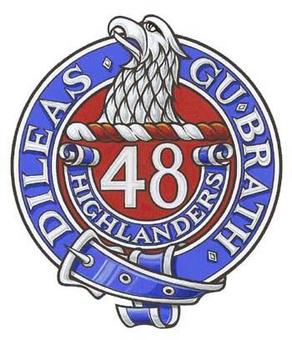
The 48th Highlanders of Canada is a Canadian Forces Primary Reserve infantry regiment based in Toronto, Ontario, parading out of Moss Park Armoury. The regiment is part of 4th Canadian Division's 32 Canadian Brigade Group.

The King's African Rifles (KAR) was a British Colonial Auxiliary Forces regiment raised from Britain's East African colonies in 1902. It primarily carried out internal security duties within these colonies along with military service elsewhere during the world wars and other conflicts, such as the Malayan Emergency and the Mau Mau uprising. The regiment's enlisted soldiers were drawn from the native Africans, while most officers were seconded from the British Army. During the 1960s, as part of the decolonisation of Africa, more African officers were commissioned into the regiment before it was gradually disbanded. KAR battalions would go on to form the core of newly established armed forces throughout East Africa.

The South African 3rd Infantry Division was an infantry division of the South African Army during World War II.
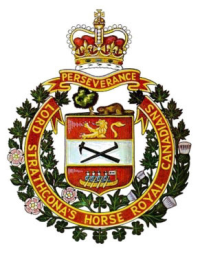
Lord Strathcona's Horse (Royal Canadians) (LdSH[RC]) is a regular armoured regiment of the Canadian Army and is Canada’s only tank regiment. Currently based in Edmonton, Alberta, the regiment is part of 3rd Canadian Division's 1 Canadian Mechanized Brigade Group. Members of the regiment are commonly called Strathconas or Strats as a short form. It was one of the last regiments in the British Empire to be created and raised by a private individual, Donald Alexander Smith, 1st Baron Strathcona and Mount Royal.

The Calgary Highlanders is a Canadian Army Primary Reserve infantry regiment, headquartered at Mewata Armouries in Calgary, Alberta, Canada. The regiment is a part-time reserve unit, under the command of 41 Canadian Brigade Group, itself part of 3rd Canadian Division, one of four region-based Canadian Army divisions. The regiment is one of only two regiments in the Canadian Forces to wear an honorary distinction on their uniform, commemorating the counterattack at Kitcheners' Wood. On 9 January 2015, the regiment was recognized with the Canadian Forces' Unit Commendation for outstanding contributions to the war in Afghanistan.

The Royal Highland Fusiliers, 2nd Battalion, The Royal Regiment of Scotland is an infantry battalion of the Royal Regiment of Scotland.

The Glengarry bonnet is a traditional Scots cap made of thick-milled woollen material, decorated with a toorie on top, frequently a rosette cockade on the left side, and ribbons hanging behind. It is normally worn as part of Scottish military or civilian Highland dress, either formal or informal, as an alternative to the Balmoral bonnet or Tam o' Shanter.

The Solomon Mahlangu Regiment is a reserve infantry regiment of the South African Army.

The Cape Town Highlanders is a reserve mechanised infantry regiment of the South African Army.
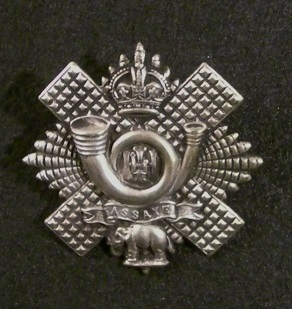
The Highland Light Infantry (HLI) was a light infantry regiment of the British Army formed in 1881. It took part in the First and Second World Wars, until it was amalgamated with the Royal Scots Fusiliers in 1959 to form the Royal Highland Fusiliers which later merged with the Royal Scots Borderers, the Black Watch, the Highlanders and the Argyll and Sutherland Highlanders to form the Royal Regiment of Scotland, becoming the 2nd Battalion of the new regiment.
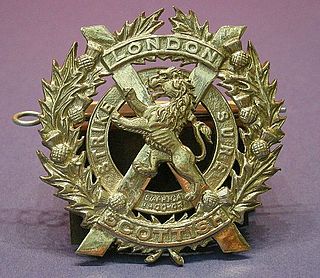
The London Scottish was a reserve infantry regiment then a company of the British Army. In its final incarnation it was A Company, the London Regiment until, on 1 May 2022, soldiers in the company transferred to foot guards regiments and the company became G (Messines) Company, Scots Guards, 1st Battalion London Guards.
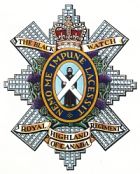
The Black Watch of Canada is a reserve infantry regiment in 34 Canadian Brigade Group, 2nd Canadian Division, of the Canadian Army. The regiment is located at 2067, rue Bleury in Montreal, Quebec, Canada, and is currently commanded by Lieutenant-Colonel R.M. Unger, MMM,CD. The regiment's armoury was designated a National Historic Site of Canada in 2008. They are the senior Canadian-Scottish Regiment.

A Scottish regiment is any regiment that at some time in its history has or had a name that referred to Scotland or some part thereof, and adopted items of Scottish dress. These regiments were created after the Acts of Union in 1707 between England and Scotland, either directly serving Britain during its various wars, or as part of the military establishments of Commonwealth countries. Their "Scottishness" is no longer necessarily due to recruitment in Scotland nor any proportion of members of Scottish ancestry.

The Royal Regiment of Scotland is the senior and only Scottish line infantry regiment of the British Army Infantry. It consists of three regular and two reserve battalions, plus an incremental company, each formerly an individual regiment. However, three regular battalions maintain their former regimental pipes and drums to carry on the traditions of their antecedent regiments.

The Scottish Horse was a Yeomanry regiment of the British Army's Territorial Army raised in 1900 for service in the Second Boer War. It saw heavy fighting in both the First World War, as the 13th Battalion, Black Watch, and in the Second World War, as part of the Royal Artillery. It amalgamated with the Fife and Forfar Yeomanry to form the Fife and Forfar Yeomanry/Scottish Horse in 1956. The lineage is maintained by "C" Fife and Forfar Yeomanry/Scottish Horse Squadron of The Scottish and North Irish Yeomanry based in Cupar in Fife.
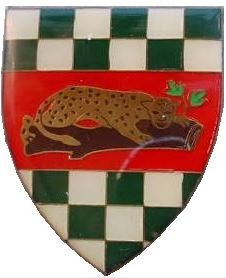
The Chief Makhanda Regiment is a reserve air assault infantry regiment of the South African Army.

The Regimental Pipes and Drums of The Calgary Highlanders is an authorized volunteer pipe band associated with The Calgary Highlanders of the Canadian Forces. For many years, the band was a bona fide, and separate, military unit unto itself, with a separate Unit Identification Code within the CF. Today, the band has been reduced to volunteer status but officially maintains an establishment of eight paid military musicians on its rolls. The band has had mixed success in competitions, but under the direction of Pipe Major Michael Giles had become successful in the Grade Three circuit in Alberta in the years leading up to the regimental centennial in 2010. The band published a recording to commemorate the 80th anniversary of the Regiment in 1990, titled Eighty Years of Glory and commemorated its centennial in 2010 by releasing a second CD entitled Onward.
The Lowland Band of the Royal Regiment of Scotland is a military band in the Territorial Army and one of three military bands in the Royal Regiment of Scotland. The band is based at the East Claremont Street drill hall in Edinburgh and is administered by 52nd Lowland, 6th Battalion, The Royal Regiment of Scotland. The other two bands in the Regiment are the regular Regimental Band of the Royal Regiment of Scotland, which is based at Dreghorn Barracks in Edinburgh and is administered by the Royal Corps of Army Music, and the other is the territorial Highland Band of the Royal Regiment of Scotland, which is based at Queen's Barracks in Perth and administered by 51st Highland, 7th Battalion, The Royal Regiment of Scotland.

There are currently 9 main military bands currently belonging to the South African National Defence Force (SANDF), which represent the different branches of the SANDF and providing music on ceremonial occasions. Since military bands were introduced in the country, they have played a prominent role in public and military life. Pipe bands also play an important role in South African military music, with notable pipe bands coming from the Cape Town Highlanders, Transvaal Scottish Regiment and the South African Military Health Service. Military bands of the SANDF are also affiliated with the police bands of the South African Police Service. In addition to military music, military bands in the SANDF perform different genres, including classical, jazz, pop and light music.
The Pipes and Drums of The Cameron Highlanders of Ottawa is an authorized pipe band in the Canadian Forces, attached to of Headquarters and Service Company of The Cameron Highlanders of Ottawa. It provides musical support for regimental and extra-Regimental activities as directed by the commanding officer. Outside of musical duties, the 25-members of the Pipes and Drums participate in Individual Battle Task Standards (IBTS), which requires it to augment "A" Company during field training exercises.






















